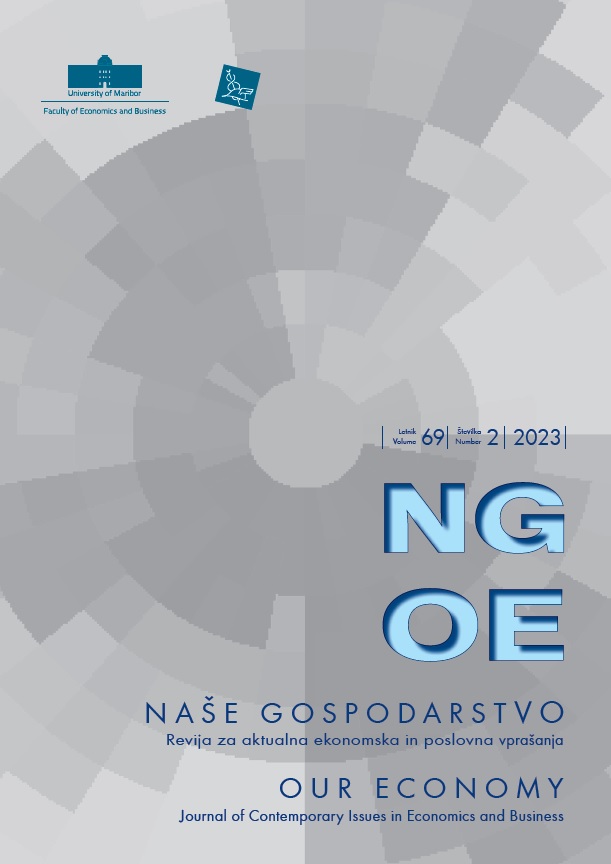Tourism Demand in Tunisia: A VECM Approach
Ključne besede:
turistična industrija, turistično povpraševanje, VECM, kointegracija, TunizijaPovzetek
Namen te raziskave je bil preučiti determinante turističnega povpraševanja v Tuniziji od leta 1995 do leta 2019 s štirimi neodvisnimi spremenljivkami: bruto domačim proizvodom, indeksom cen življenjskih potrebščin, realnim menjalnim tečajem in številom prepeljanih potnikov v zračnem prometu. V raziskavi so bili uporabljeni testi enotskih korenov, kointegracijski test in model vektorske korekcije napak (VECM) za preučitev dinamike kratkoročnih in dolgoročnih razmerij med spremenljivkami. Rezultati kažejo, da med spremenljivkami obstajajo kointegracijski odnosi; vse neodvisne spremenljivke negativno vplivajo na turistično povpraševanje, razen letalskega prevoza. Glede na dobljene rezultate bi se morali oblikovalci politik zavedati negativnega vpliva politične nestabilnosti države na obseg zunanjega turističnega povpraševanja. V tem smislu mora vlada ponovno vzpostaviti politično stabilnost, da bi turiste spodbudila k obisku Tunizije. Prihodnje študije bi morale upoštevati dejavnike, kot so trgovinska odprtost gospodarstva in cene nafte.
Literatura
Adeola, O., Boso, N., & Evans, O. (2018). Drivers of international tourism demand in Africa. Business Economics, 53(1), 25–36. DOI: https://doi.org/10.1057/S11369-017-0051-3
Baghirov, A., & Sarkhanov, T. (2023). The Influence of Incoming Tourists and Consumer Price Index on Tourism Receipts. African Journal of Hospitality, Tourism and Leisure, 12(1), 16–30. DOI: https://doi.org/10.46222/ajhtl.19770720.351
Balsalobre-Lorente, D., Driha, O. M., Bekun, F. V., & Adedoyin, F. F. (2021). The asymmetric impact of air transport on economic growth in Spain: fresh evidence from the tourism-led growth hypothesis. Current Issues in Tourism, 24(4), 503–519. DOI: https://doi.org/10.1080/13683500.2020.1720624
Bozkurt, C. (2014). Money, Inflation and Growth Relationship: The Turkish Case. International Journal of Economics and Financial Issues, 4(2), 309–322. Retrieved from https://www.econjournals.com/index.php/ijefi/article/view/750
Chi, J. (2020). The impact of third-country exchange rate risk on international air travel flows The case of Korean outbound tourism demand. Transport Policy, 89, 66–78. DOI: https://doi.org/10.1016/J.TRANPOL.2020.01.012
Doerr, L., Dorn, F., Gaebler, S., & Potrafke, N. (2020). How new airport infrastructure promotes tourism: evidence from a synthetic control approach in German regions. Regional Studies, 54(10), 1402–1412. DOI: https://doi.org/10.1080/00343404.2020.1714022
Göçer, İ., Görmüş, Ş., & Göçer, S. (2010). The socio-economic determinant of tourism demand in Turkey: A panel data approach. International Research Journal of Finance and Economics, 55, 88-99. Retrieved from http://www.eurojournals.com/finance.htm
Hącia, E. (2019). The role of tourism in the development of the city. Transportation Research Procedia, 39(2), 104–111. https://doi.org/10.1016/j.trpro.2019.06.012
Ivanovski, Z., Milenkovski, A., & Narasanov, Z. (2018). Time Series Forecasting Using a Moving Average Model for Extrapolation of Number of Tourists. UTMS Journal of Economics, 9(2), 121–132.
Jin, X. (Cathy), Bao, J., & Qu, M. (2021). Can tourism be a policy tool to moderate the trade balance? Annals of Tourism Research, 86. DOI:https://doi.org/10.1016/J.ANNALS.2020.102946
Khoshnevis Yazdi, S., & Khanalizadeh, B. (2016). Tourism demand: a panel data approach., 20(8), 787–800. DOI: https://doi.org/10.1080/13683500.2016.1170772
Martins, L. F., Gan, Y., & Ferreira-Lopes, A. (2017). An empirical analysis of the influence of macroeconomic determinants on World tourism demand. Tourism Management, 61, 248–260. DOI: https://doi.org/10.1016/J.TOURMAN.2017.01.008
Ongan, S., Işik, C., & Özdemir, D. (2017). The Effects of Real Exchange Rates and Income on International Tourism Demand for the USA from Some European Union Countries. Economies 2017, 5(4), 51. DOI: https://doi.org/10.3390/ECONOMIES5040051
Pavlic, I., Svilokos, T., & Tolic, M. S. (2015). Tourism, Real Effective Exchange Rate, and Economic Growth: Empirical Evidence for Croatia. International Journal of Tourism Research, 17(3), 282–291. DOI: https://doi.org/10.1002/JTR.1986
Rafiei, F., & Abbaspoor, N. (2021). The impact of exchange rate on domestic tourism demand of Iran. Anatolia, 33(3), 451-462. DOI: 10.1080/13032917.2021.1964553
Suhel, S., & Bashir, A. (2018). The role of tourism toward economic growth in the local economy. Economic Journal of Emerging Markets, 10(1), 32–39. DOI: https://doi.org/10.20885/EJEM.VOL10.ISS1.ART4
Prenosi
Objavljeno
Številka
Rubrika
Licenca
Avtorske pravice (c) 2023 Djamal Dekkiche

To delo je licencirano pod Creative Commons Priznanje avtorstva-Nekomercialno-Brez predelav 4.0 mednarodno licenco.
